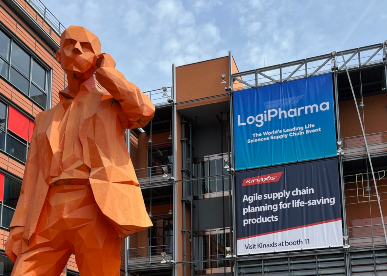

In late April, hundreds of pharmaceutical and supply chain leaders from around the world converged in beautiful Lyon, France for the annual LogiPharma conference. Resilience, agility, and digitalization of supply chain operations continued to be top-of-mind and prolific topics throughout the conference. Rather than spend time on lofty hypotheticals, speakers and attendees were focused on real-world goals to operationalize forward-thinking approaches to the industry’s biggest supply chain challenges (and opportunities).
Here are a few highlights from this insightful gathering of pharma and supply chain leaders.
The human element of supply chain management
Kinaxis CEO John Sicard joined a panel with customer Brian Thornley of MSD about utilizing supply chain digital twins to achieve resilience. John shared that the key to achieving supply chain agility and resiliency doesn’t sit with the right technology alone – but rather requires coupling the right technology with more efficient and widely-accepted processes.
Instead of throwing technology at an issue, organizations should ask supply chain professionals, “why are you experiencing this pain?” According to the panel, the most likely answer will be, “because someone ran out of time.” To combat this, John noted the importance of speed in risk detection, saying, “If you can accelerate the time to detect it, you can accelerate the speed to correct it.”
He also shared that supply chains are inherently human, but by automating the obvious, planners are empowered to focus on more complex, value-add work.
EQRx’s RapidStart approach to digital transformation
Ian Howard, Head of Supply Chain and OpEx for EQRx and Director of Supply Chain Planning for EQRx, Lou Lozanov shared a session on how they jumpstarted their supply chain digital transformation with the Kinaxis RapidStart approach. They talked about how their digital transformation eliminated the guesswork needed to manage their supply chain. Now, they can “understand the root cause of a risk and then figure out how to mitigate it.”

EQRx is a start-up in the midst of bringing its products to market, so the company is necessarily cash conscious. That’s why concurrent planning has been a strong fit for the company’s needs, according to Lou. “We can pinpoint millions in cost avoidance due to our S&OP cadence with Kinaxis and can escalate issues more efficiently to our executive leadership.”
Trend throughlines at the conference
Supply chain sustainability was a recurring, key topic at the conference, as attendees sought insights regarding how to balance the necessity of good patient outcomes with environmental impact.
Fortunately, some innovative ideas to tackle the issue were discussed by panelists. During a logistics panel, there was talk about utilizing cargo shipping for pharma transport. While pharma hasn’t traditionally been considered a good lane for transport due to container volume requirements and slow-moving nature, organizations are starting to consider cargo transport more seriously. After all, it could potentially be a way to cut costs and decrease the heavy environmental impact of air freight. Panelists agreed that, in general, this option is better for high volume, low risks products, but there was also an interesting conversation about partnering in container splitting to optimize the space utilized in the container and still meet delivery targets.
I think this speaks to a broader trend of companies seeking to expand partnerships in areas that may be viewed as a competitive disadvantage; but doing so is a creative way to address the sustainability requirements of governments, organizations and consumers.
Another intriguing sustainability topic was shifting away from printed leaflets with drug shipments, which is currently a requirement of most drug ministries. Moving to a QR code approach on a bottle could not only decrease paper waste but also help decrease the jurisdictional control requirements – for instance, if a single QR code could redirect to drug information in multiple languages.

Personalized medicine delivery was another popular point of conversation, especially regarding cell and gene therapy. In a panel, an audience poll showed a likely move toward a personalized approach, but the percentage of the audience’s business expected to be dedicated to this model varied. The panel also acknowledged the low volume, high costs of personalized medicine as prohibitive toward adopting a broader effort in this area, at least in the near term. That said, it will be interesting to follow how the model works out over time for the pharma manufacturers already delivering personalized medicine, including for rare disease treatments.
Overall, LogiPharma 2023 was an outstanding event. It was packed with thought-provoking content regarding supply chain planning in this complex industry, and it was a fantastic opportunity to meet so many of our Kinaxis pharma customers.
If you’d like to read further on supply chain management’s largest challenges this year, be sure to check out 12 supply chain trends to watch out for in 2023 by Matt Spooner.



